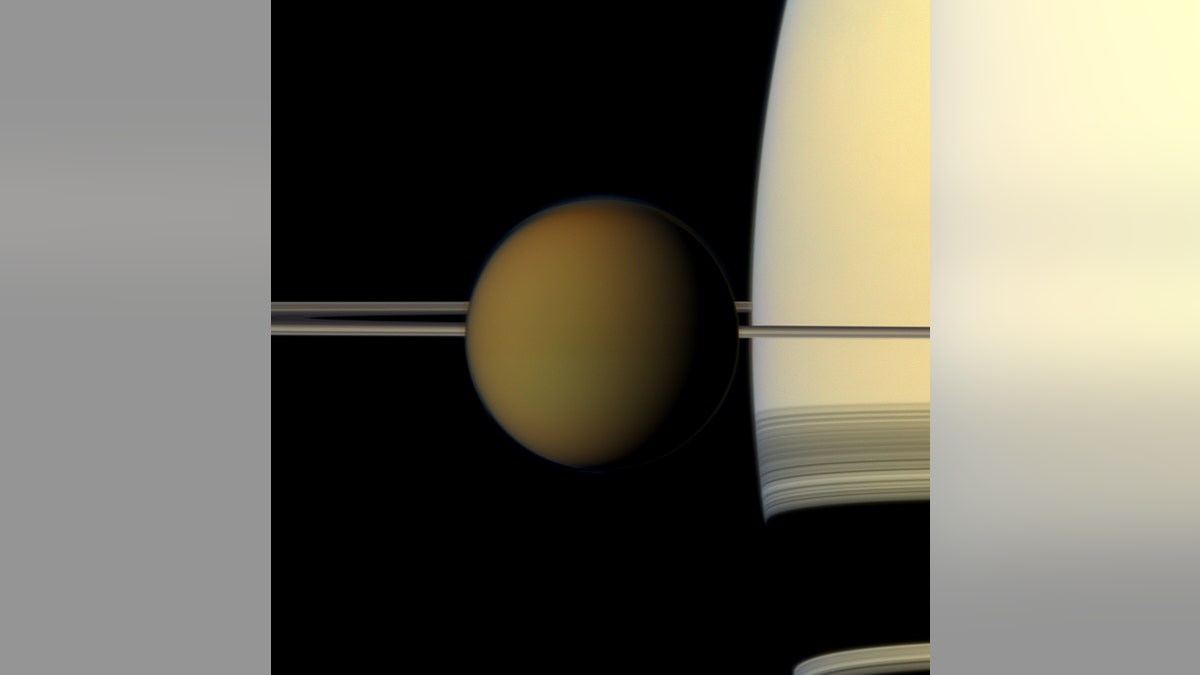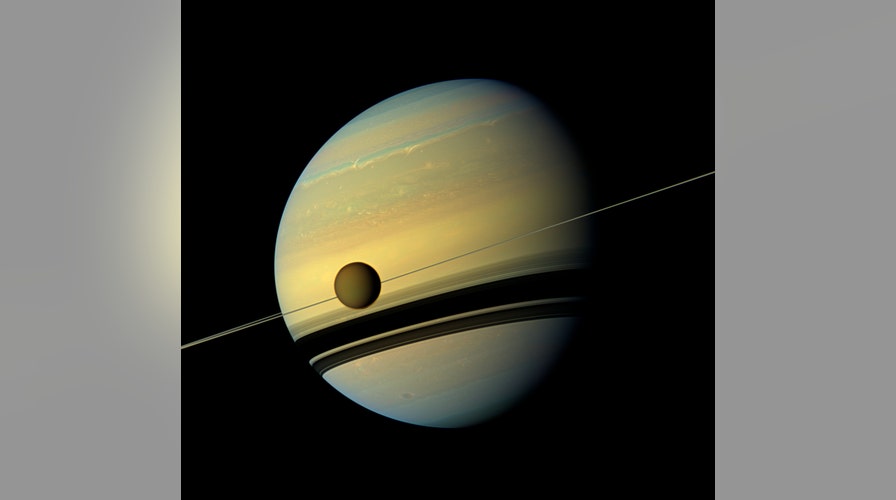Fox News Flash top headlines for June 9
Fox News Flash top headlines are here. Check out what's clicking on Foxnews.com.
Researchers have discovered that Saturn's moon, Titan, which could support extraterrestrial life, is moving away from the ringed planet 100 times faster than previously believed.
The study, published in Nature Astronomy, found that Titan is migrating away from Saturn at a rate of about four inches per year, which could reshape how astronomers view the Solar System and the universe itself.
"This result brings an important new piece of the puzzle for the highly debated question of the age of the Saturn system and how its moons formed," said the study's lead author, Valery Lainey, who previously worked at NASA JPL, in a statement.

The colorful globe of Titan passes in front of Saturn and its rings in this true-color snapshot from NASA's Cassini spacecraft in 2011. Image credit: NASA/JPL-Caltech/Space Science Institute
MYSTERIOUS SATURN MOON COULD BE BEST PLACE TO LOOK FOR EXTRATERRESTRIAL LIFE, TOP PHYSICIST SAYS
In a separate statement, Caltech assistant professor of theoretical astrophysics and study co-author Jim Fuller said that previous research into other planet's moons were predicated on their distance being relatively stable compared to their planets. Caltech manages JPL for NASA.
"Most prior work had predicted that moons like Titan or Jupiter's moon Callisto were formed at an orbital distance similar to where we see them now," Fuller said. "This implies that the Saturnian moon system, and potentially its rings, have formed and evolved more dynamically than previously believed."
"The new measurements imply that these kind of planet-moon interactions can be more prominent than prior expectations and that they can apply to many systems, such as other planetary moon systems, exoplanets - those outside our solar system - and even binary star systems, where stars orbit each other," Fuller added.
Titan is approximately 746,000 miles away from Saturn. By comparison, the moon is 238,900 miles away from Earth and moves away from the planet at a rate of 1.5 inches every year.
The researchers used data from NASA's Cassini spacecraft, along with historical observations of the moon dating back to 1886, to come up with their findings.

This near-infrared, color view from Cassini shows the sun glinting off of Titan's north polar seas. (Credit: NASA/JPL-Caltech/Univ. Arizona/Univ. Idaho)
In September 2017, Cassini made its "death plunge" into Saturn’s atmosphere, ending its 20-year long journey.
SATURN'S MOON TITAN HAS A LAKE WITH FEATURES SIMILAR TO EARTH, COULD SUPPORT LIFE
Titan continues to be a source of fascination for researchers, with some even suggesting it could support life. In June 2019, NASA announced the latest mission in its New Frontiers program to explore the moon.
Known as Dragonfly, the mission will see a rotorcraft fly "to dozens of promising locations" on Titan after it arrives in 2034, following a 2026 launch.
Titan's atmosphere is four times as dense as Earth's, with NASA likening it to that of early Earth. In April, researchers discovered that lakes on Titan are filled with liquid methane, utilizing data from Cassini. Dust storms were spotted on the celestial satellite in September 2018, which raised the prospect the storms could be a precursor to alien life on the celestial body.
In January 2019, researchers revealed that fresh rainfall had been spotted on Titan in 2016, which caused a reflective feature near the north pole of the moon.
Titan is not the only celestial satellite of Saturn to intrigue scientists. In June 2018, researchers acknowledged that they had found the "building blocks" for life on Enceladus, having discovered complex organic molecules.
CLICK HERE TO GET THE FOX NEWS APP





















